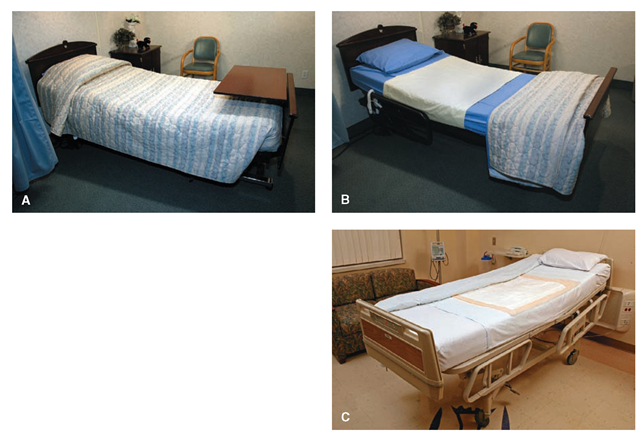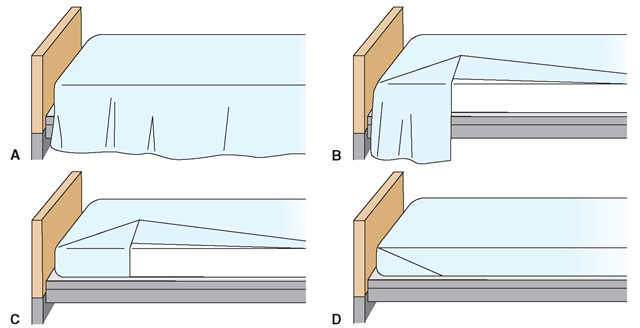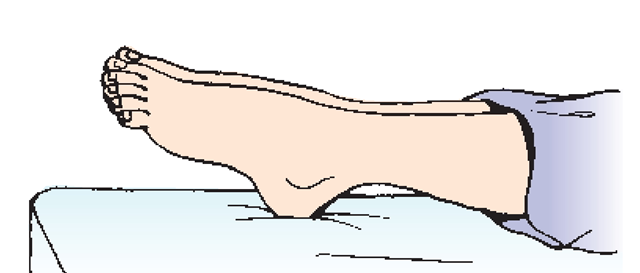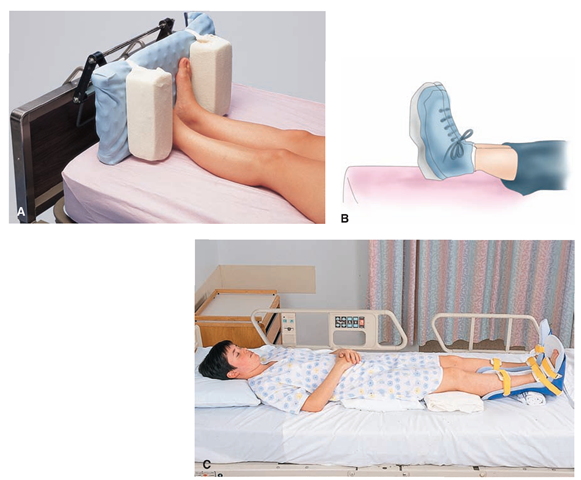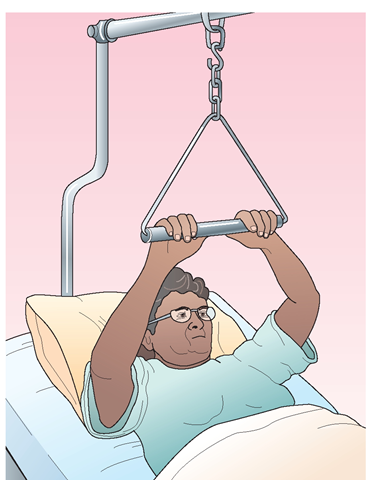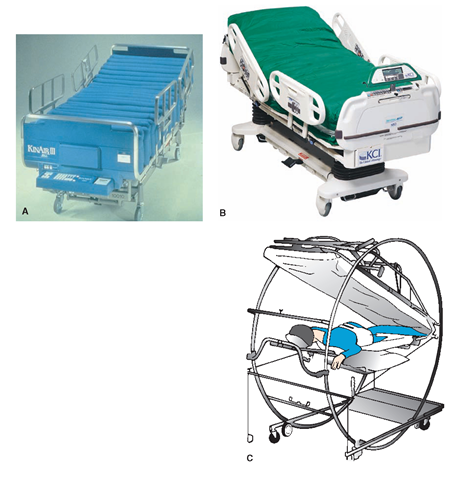Learning Objectives
1. State the purposes of bed making in the healthcare facility.
2. Demonstrate the ability to make an unoccupied, occupied, and postoperative bed.
3. Demonstrate the ability to open a bed for a client.
4. Describe the use of a bed cradle.
5. Explain the purpose of side rails and demonstrate the ability to adjust side rails safely.
6. Describe three devices that may be added to the hospital bed and their uses.
7. Identify the purposes of specialized hospital beds. Describe at least three specialized beds.
|
IMPORTANT TERMINOLOGY |
||
|
bed cradle |
footdrop |
traction |
|
closed bed |
mitered (corners) |
trapeze |
|
egg crate mattress |
occupied bed |
unoccupied bed |
|
flotation mattress |
open bed |
|
|
footboard |
postoperative bed |
|
Some clients are so ill that they are totally or partially confined to bed. A bed should provide comfort and correct posture for the client, as well as proper height and accessibility for caregivers. The ideal bed is durable, lightweight, easy to move, and easy to clean.
The most commonly used bed in healthcare facilities adjusts to different positions. (This is called a Gatch bed.) This bed is equipped with an electric mechanism that lowers the entire bed so that the client can get in and out easily and raises the bed for easy caregiving. The mechanism can lower and raise the head and foot of the bed as well. Often both the client and caregivers can use controls to position the bed as desired. Usually, the controls for the TV, reading light, and the nurse call are incorporated into the bed controls. (In some areas, the Gatch adjustments may be operated using a hand crank.)
Key Concept The controls on a hospital bed can be locked so the client cannot adjust the bed.This may be necessary in the event of a delicate suture line or unset fracture. In these cases, adjusting the bed could cause client discomfort and could be dangerous to the client.
BED MAKING
The purpose of bed making is to help clients feel comfortable and to decrease pathogens in the client’s environment. Clean, dry, and wrinkle-free linens also help to reduce the potential for skin breakdown and they are important to help control odor.
Necessary supplies for bed making include clean linens, a tight bottom sheet to prevent wrinkles that might cause skin irritation, and upper bed clothing that does not weigh on the client’s body or restrict movements, but still covers his or her shoulders. Adjustments in basic bed making may be necessary for comfort and to suit individual client conditions.
Schedules for changing beds vary among healthcare agencies. Usually you remake the bed after the client’s bath or morning care. Make exceptions if the linen becomes soiled or if changing the bed may prove harmful to the client. For example, a client may be bleeding, receiving a special treatment, or feeling too weak or exhausted to be disturbed. Change stained sheets immediately. In some cases, beds are not changed every day or are partially changed. Even if you do not change the bed, tuck in sheets and blankets, to get rid of wrinkles, and fluff the pillows.
Key Concept Every client needs a smooth, clean bed for comfort and to prevent complications. Wrinkles or crumbs can make the client uncomfortable and cause skin breakdown. It is very important to change linens that are soiled. One or more incontinence pads are added to the linens on the bed if the client is bleeding, incontinent, or vomiting.
Key Concept The client with an orthopedic disorder often requires a head-to-toe linen change, sometimes more than once a day This client must be moved very carefully particularly if he or she has an unstabilized fracture.
Proper body mechanics are an essential part of bed making. Put them into practice.
Making an Unoccupied Bed
An unoccupied bed is a bed that is empty at the time it is made and it is the easiest bed to make. The unoccupied bed can be made either as a closed bed or as an open bed. When no client has been assigned to the bed, it is made as a closed bed. An open bed is a bed to which a client is already assigned.
To make a closed bed, the top covers are pulled up to the head of the bed over the bottom covers. A pillow is placed on top of the linens or is covered with the bedspread, much as you would do in your home (Fig. 49-1A). To make the open bed, the top covers are fan-folded to the foot of the bed so the client can get into bed easily (Fig. 49-1B). Steps in making an open bed and closed bed are shown in In Practice: Nursing Procedure 49-1. Figure 49-2 demonstrates how to make a mitered corner. After making any bed, look to see if the linens are straight, firmly tucked under the mattress, smooth and without wrinkles, and hanging evenly on both sides.
Making an Occupied Bed
Some clients are unable to get out of bed as a result of their specific condition or generalized weakness. Changing bed linens with the client in the bed is known as making an occupied bed. Work quickly and disturb the client as little as possible. This task of bed making may be done by one nurse; however, if the client is large or his or her medical condition is unstable, ask a coworker to assist you. In Practice: Nursing Procedure 49-2 gives the steps in making an occupied bed. If done efficiently, this procedure requires minimum exertion for both you and the client. Some clients need extra blankets for additional warmth, and some may have fractures or injuries that necessitate turning or moving them in a special way.
Opening a Bed for a Client
The open bed has the linens folded down, making it easier for the client to get into bed. Open a bed for a new client or leave it open when the client is out of bed for a short time. Follow these steps:
FIGURE 49-1 · Methods of making beds. (A) A closed bed is an unoccupied bed. (B) When a closed bed is “opened,” the top sheet, blanket, and bedspread are fan-folded to the foot of the bed, for easy entry by the client. Note that a draw sheet is in place, to help protect the bed and to facilitate turning the client. The bed is kept in low position for safety. (C) A surgical or postoperative bed is a closed bed that has been “opened” to receive a person on a stretcher The top linens are fan-folded to the side of the bed and out of the way. This bed is usually in high position, to conveniently receive the client from the stretcher.
FIGURE 49-2 · How to make a mitered corner Here, a mitered corner is being made on a flat bottom sheet. (A) The sheet is hanging over the side of the bed. (B) Grasp the edge of the sheet about 12 inches from the foot of the bed and lift it up, forming a triangle. Lay the triangular fold on the top of the bed, and smooth the hanging portion of the sheet against the side of the mattress. (C) Tuck the hanging portion of the sheet underneath the mattress, while holding the triangular fold taut against the top of the bed. (D) Bring the triangular fold back down over the edge of the mattress, and tuck it underneath. This process is the same for the upper corners of the bed and for the top linens.
• Turn the bedspread down from the top, and fold it around and over the top edge of the blanket. Then fold the sheet over the top of the blanket and spread. Rationale: This protects the blanket, keeps the rougher blanket away from the client’s skin, and makes it easier for the client to handle the bedclothes.
• Turn the top bedding down to the foot of the mattress and fold it back on itself. Rationale: This shows the client that the bed is ready. Helping the person into bed is also easier when the bed is open.
• Always leave the bed in low position when you have completed caring for the client. Rationale: This is vital to prevent falls.
Making a Postoperative Bed
When a client is to return from the operating room or from another procedure that requires transfer into bed from a stretcher and sometimes from a wheelchair, a postoperative bed is prepared. The postoperative bed is made in such a way as to make it easy to transfer the client from a stretcher to the bed (Fig. 49-1C). In Practice: Nursing Procedure 49-3 outlines the steps in making this bed.
ATTACHMENTS AND ACCESSORIES
Bed Cradle
A bed cradle is a frame used to prevent the bedclothes from touching all or part of the client’s body. It is used for clients with fractures, extensive burns, and open or painful wounds. A wide cradle fits all the way along the bed lengthwise. A narrow one also fits along the bed lengthwise; it can be used over one arm or leg. Bed cradles are usually made of metal or plastic. Some bed cradles contain a low-level heating device. Arrange bed linens over the cradle. In some instances, you will fasten the linens to the cradle or frame. Leave the linens long enough at the top to cover the client’s shoulders comfortably. Place side rails up for safety. Discourage clients from adjusting the bed controls to avoid displacing the cradle and causing injury to themselves. (You may need to lock the controls so the client does not forget.) In Practice: Nursing Procedure 49-4 describes how to make a bed that includes a bed cradle.
Side Rails
Side rails (safety rails) are bed rails that not only prevent clients from falling out of bed, but also help the client to change position while in bed. They often incorporate TV controls and the nurse call signal as well. Sometimes, however, these bed rails alarm older or confused clients. Most facilities have a standard policy regarding the use of side rails. Make it your practice to be aware of these policies and to follow protocols, always keeping the safety of your clients in mind.
Nursing Alert In some cases, having the side rails up can be more dangerous than having them down. For example, an elderly client may continually try to crawl out of bed. In this case, he or she might crawl over the side rails, making a potential fall worse than if it were just from the lower level of the bed.
It is natural for a client to resent side rails. Many people fear being shut in or treated as if they are irresponsible.
Explain to the client and family that side rails are for the client’s protection. If protecting the client from pressure or possible injury is necessary, cushion the side rails of the bed with a mattress pad, bath blanket, seizure pads, or pillows. Restless or confused clients may press or throw themselves against the hard side rails or may attempt to climb over them.
Key Concept Nearly all of today’s hospital beds have side rails attached.The fact that theTV and other controls are integrated into the side rails helps to remove clients’ resistance to having them. (Everyone else has side rails too.)
Other Equipment
A footboard may be attached to the foot of the bed to prevent abnormal plantar flexion or a deformity called footdrop, which may occur when a client remains in bed for a prolonged period of time (Fig. 49-3).The footboard has a slight angle to it and is placed to support the client’s feet in a simulated standing position (Fig. 49-4A). Several alternatives to the footboard, such as foot splints and high-top shoes, are also available (Fig. 49-4B, C).
A bed board may be placed under the mattress to support the body in correct alignment. A CPR (cardiopulmonary resuscitation) headboard is available on nearly all hospital beds. The headboard of the bed is easily removable, for placement under the client if CPR is needed (Fig. 49-5). In some cases, a separate CPR board is attached to the bed. The crash cart contains a CPR board as well (see Fig. 43-7), or a transfer board may be used.
FIGURE 49-3 · Abnormal plantar flexion, if not corrected, may lead to a deformity called footdrop.
Hospital beds are also equipped with a means for attaching an IV standard that holds the bags for intravenous (IV) or blood therapy. (The standard itself is often stored on a rack under the bed, for easy access.) Additional equipment, such as suction containers, catheter bags, or client reminder devices, may also be clamped onto the bed frame.
A trapeze, a horizontal bar hanging on chains, is often attached to a large overhead frame, which itself attaches to the bed (Fig. 49-6). The trapeze is used by the client to pull up to a sitting position or to lift the shoulders and hips off the bed.
FIGURE 49-4 · Prevention of foot-drop. (A) A padded footboard is placed at the foot of the bed. The padding helps prevent skin breakdown. The footboard keeps the feet in proper alignment (dorsiflexion). (B) High-top shoes are an alternative to the footboard, particularly if the person moves about in bed a great deal. (C) Protective boots (foot splints) are also available to prevent footdrop.
FIGURE 49-5 · (A) Removing the headboard for cardiopulmonary resuscitation (CPR). (B) The headboard is placed under the client’s upper body to provide a firm surface for resuscitation. A transfer board may also be used for this purpose.
The trapeze is also used to exercise and strengthen the arms, particularly if the client will be using crutches or is a person with paraplegia (paralyzed from the waist down).
The client may be placed in traction. Traction consists of a series of ropes, pulleys, and weights that serve to keep a body part, such as a leg, in proper alignment. Generally, the bed of the client in traction is changed with the person in the bed (an occupied bed). However, for this client, the used linens are removed and the new linens are brought down from head to toe. This is different than the traditional method of making an occupied bed.
FIGURE 49-6 · An overbed frame with a trapeze allows the client to lift the upper body off the bed and to move about in bed. It can also be used for bed exercises.
Nursing Alert Do not remove traction weights without your supervisors instruction.
NCLEX Alert Priority NCLEX concepts are the client safety promotion of skin integrity, and prevention of infection. Client care may integrate these concepts. You need to choose the appropriate action or response.
SPECIAL BEDS AND MATTRESSES
Special types of mattress surfaces are used for clients on prolonged bed rest or for those with poor skin integrity. Examples include the egg crate mattress, which is foam rubber with a surface shaped like an egg carton, and the flotation mattress or pad (usually used in a specific area of the body). The flotation mattress or pad contains a special gel-type material, which supports the body or body part in such a way as to avoid creating pressure points. Although egg crate mattresses and flotation pads provide client comfort, they do not necessarily prevent skin breakdown.
Therapeutic beds are used to treat clients with severe joint contractures, prolonged immobility, or skin wounds such as pressure ulcers or severe burns. These beds reduce or relieve the effects of pressure against the skin through various mechanisms. The surface of such beds often feels like a waterbed. These beds are more comfortable for clients who have severe contractures because their bodies float as if suspended in midair. Severe skin wounds are more likely to heal when the effects of pressure are reduced. Some special beds are pictured in Figure 49-7. Many special beds also are available in sizes that accommodate very large or heavy clients.
Special orthopedic beds and frames support clients who must remain immobilized. Although largely replaced by other computerized beds and overlay mattresses, the circle bed (Circ-O-Lectric bed) is still used in special situations (Fig. 49-7C). It functions to turn the client as a unit, keeping the body straight.
Key Concept Bariatric beds are also available for very large clients.These beds are larger than regular hospital beds and of heavier construction. Usually three people are required to move a bariatric bed.
Throughout your nursing career, you will work with clients who need therapeutic beds, many of which are complex to use. Be sure to read carefully the instructions for use, paying particular attention to safety features. You are responsible for the safe and effective use of these therapeutic beds, as well as the safety and well-being of your clients.
FIGURE 49-7 · Many specialized beds are available to enhance client care and prevent deformities. These beds also make it easier for the nurse to care for the client who is seriously ill or disabled and to provide greater safety to the client. (A) This microcomputerized bed not only greatly lessens the possibility of pressure area development, but also manages incontinence in the immobile client. It provides drainage for body fluids into the receptacle at the foot of the bed, where it can be measured. It also provides a scale and a heater and has a quick-release mechanism for cardiopulmonary resuscitation (CPR). Some beds also have a cleansing and vacuuming system for skin care. (B) The TheraPulse ATP alternating pressure bed rotates air pockets, to reduce the possibility of developing pressure areas. (C) The Circ-O-Lectric or circle bed turns the client from front (prone) to back (supine), rotating around the feet.
KEY POINTS
• Organize work. Gather all supplies before making the bed. Strip and make one side of the bed at a time to conserve time and energy.
• To prevent the spread of microorganisms, never shake linen or put it on the floor.
• Hold soiled linen away from your uniform, and never place soiled linen from one client’s bed onto another client’s bed.
• Place soiled linen in a covered laundry hamper while continuing your work. Uncovered laundry bags are usually not used.
• Keep in mind that a well-made bed promotes comfort and rest, helps prevent skin breakdown, and provides safety for clients.
• Use special attachments and beds as available to meet a particular client’s needs.
